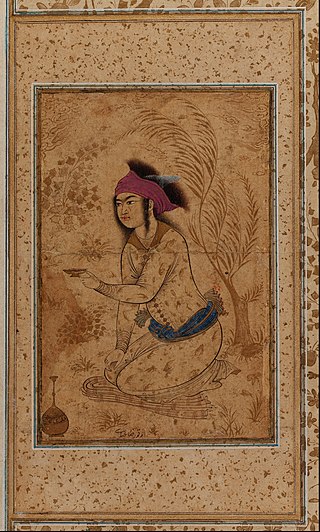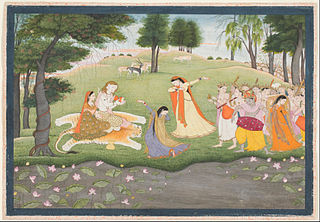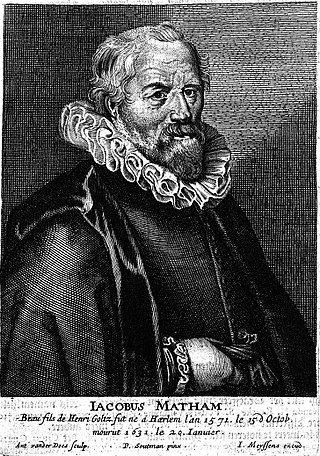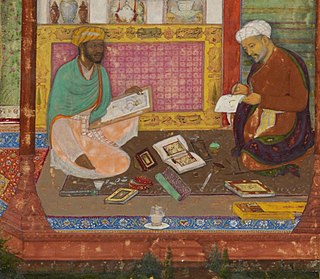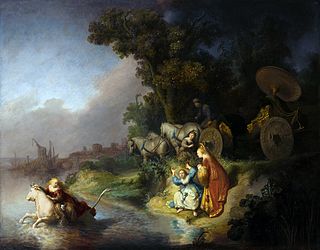| No. | Image | Title | Year | Technique | Dimensions | Gallery | Commentary |
|---|
| 1 |  | Emperor Akbar and his Son Selim in Apotheosis | c. 1656 | Pen and brown ink, brown wash and white gouache on Japan paper | Height: 21.2 cm (8.3 in); Width: 17.4 cm (6.8 in) | Museum Boijmans Van Beuningen, Netherlands | |
| 2 |  | A Mughal nobleman on horseback | c. 1656-61 | Pen and brown ink with brown and grey wash, touched with red and yellow chalk and white heightening and with some scraping-out, on oriental paper; the lance drawn with a ruler. | Height: 205 mm (8.07 in); Width: 177 mm (6.96 in) | British Museum, England | |
| 3 |  | A Deccani nobleman standing | c. 1656-61 | Pen and brown ink with grey and brown wash and scraping-out on oriental paper prepared with pale brown wash. | Height: 196 millimetres; Width: 158 millimetres | British Museum, England | |
| 4 |  | A Medallion Portrait of Muhammad Adil Shah of Bijapur, Rembrandt | c. 1656-61 | Pen, Brown Ink, And Brown Wash On Japan Paper | Height: 97mm; Width: 76mm | Fine Arts Museum of San Francisco, United States | |
| 5 |  | A Mughal Nobleman standing (Prince Daniyal) | c. 1656-61 | Pen and brown ink with grey and brown wash, touched with red chalk (in the turban) and white heightening, on Asian paper | Height: 184 millimetres; Width: 112 millimetres | British Museum, England | |
| 6 | 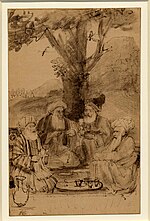 | Four Mullahs Seated under a Tree | c. 1656-61 | Pen and brown ink with brown and grey wash, touched with white and with some scraping-out, on Asian paper prepared with pale brown wash | Height: 194 millimetres; Width: 124 millimetres | British Museum, England | |
| 7 |  | Indian archer | c. 1656-58 | Pen and brown ink, with brown, grey, and light brown wash and opaque white, on Japanese paper toned with light brown wash; later additions in pen and brown ink; framing line in grey ink | , h: 188mm × w: 131mm | Rijksmuseum | |
| 8 |  | Indian Ruler (Shah Shuja') | c. 1656-61 | Brown ink and brown wash on Asian paper toned with light brown wash | Height: 23 cm; Width: 18 cm | Albertina Museum, Austria | |
| 9 |  | Indian Warrior with a Shield | c. 1654-56 | Pen and brown ink and wash, with red chalk wash, black chalk and scraping (correction), on Japanese paper | Height: 178; Width: 100 mm | Morgan Library & Museum, United States | |
| 10 |  | Portrait of Aurangzeb | c. 1655 | Brown ink, brown wash, black chalk and white opaque watercolor on Asian paper; later additions in gray wash and scratchwork, framing line in brown ink, mounted overall | Height: 18 cm; Width: 7.3 cm | Harvard Art Museums, United States | |
| 11 | 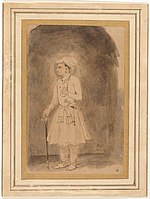 | Portrait of Jahangir | c. 1656-58 | Pen and brown ink, with brown, pink, and grey wash, on Japanese paper toned with light brown wash; framing line in brown ink | Height: 183 mm; Width: 120 mm | Rijksmuseum, Netherlands | |
| 12 | 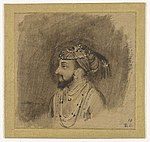 | Portrait of Shah Jahan | c. 1656-68 | Pen and brown ink, with brown wash and opaque white, on Japanese paper toned with light brown wash | Height: 69 mm; Width: 71 mm | Rijksmuseum, Netherlands | |
| 13 |  | An Indian Lady | c. 1656 | Pen and brown ink on paper | Height: 7.9 cm (3.1 in); Width: 7.2 cm (2.8 in) | Museum Boijmans Van Beuningen, Netherlands | |
| 14 |  | Shah Jahan and Dara Shikoh | c. 1656-61 | Brown ink and gray wash with scratchwork on Japanese paper prepared with pale brown wash | Height:21.3 cm; Width: 17.8 cm | J. Paul Getty Museum, United States | |
| 15 |  | Shah Jahan and his Son | c. 1656-58 | pen and brown ink, with brown wash, on Japanese paper toned with light brown wash | h 94 mm × w 86 mm | Rijksmuseum, Netherlands | |
| 16 |  | Shah Jahan | c. 1656-61 | Pen and brown ink and brush and brown wash | Height: 22.5; Width: 17.1 cm | Cleveland Museum of Art, United States | |
| 17 |  | Shah Jahan, Standing with a Flower and a Sword | c. 1656-61 | Pen and brown ink with brown wash on Asiatic paper | Height: 17.8 cm; Width: 10.1 cm | Fondation Custodia, France | |
| 18 |  | Two Indian Noblemen | c. 1654-56 | Pen and brown ink and wash, with red chalk wash, yellow watercolor, white opaque watercolor, black chalk and scraping on Japanese paper | Height: 191 mm; Width: 234 mm | Morgan Library & Museum, United States | |
| 19 |  | Two Mughal noblemen (Shah Jahan and Dara Shikoh) | c. 1656-61 | Pen and brown ink with brown and grey wash, touched with white and with scraping-out, on Asian paper prepared with pale brown wash | Height: 172 mm; Width: 214 mm | British Museum, England | |
| 20 | Image required (Private collection) | Two Heads of Women after an Indian Painting | c. 1656-61 | Brown ink and brown wash on Asian paper | Height: 6.8 cm; Width: 9.4 cm | Nicolas Joly Art Conseil, Paris | |
| 21 |  | Emperor Jahāngīr receiving an Officer | c. 1656-61 | Pen and brown ink, with brown and grey wash, touched with white, on oriental paper | Height: 210 mm; Width: 184 mm | British Museum, England | |
| 22 |  | Emperor Timur on his throne, after an Indian miniature | c. 1656-61 | Pen and ink on oriental paper | Height: 186 mm; Width: 187 mm | Musee du Louvre, France | |
|































